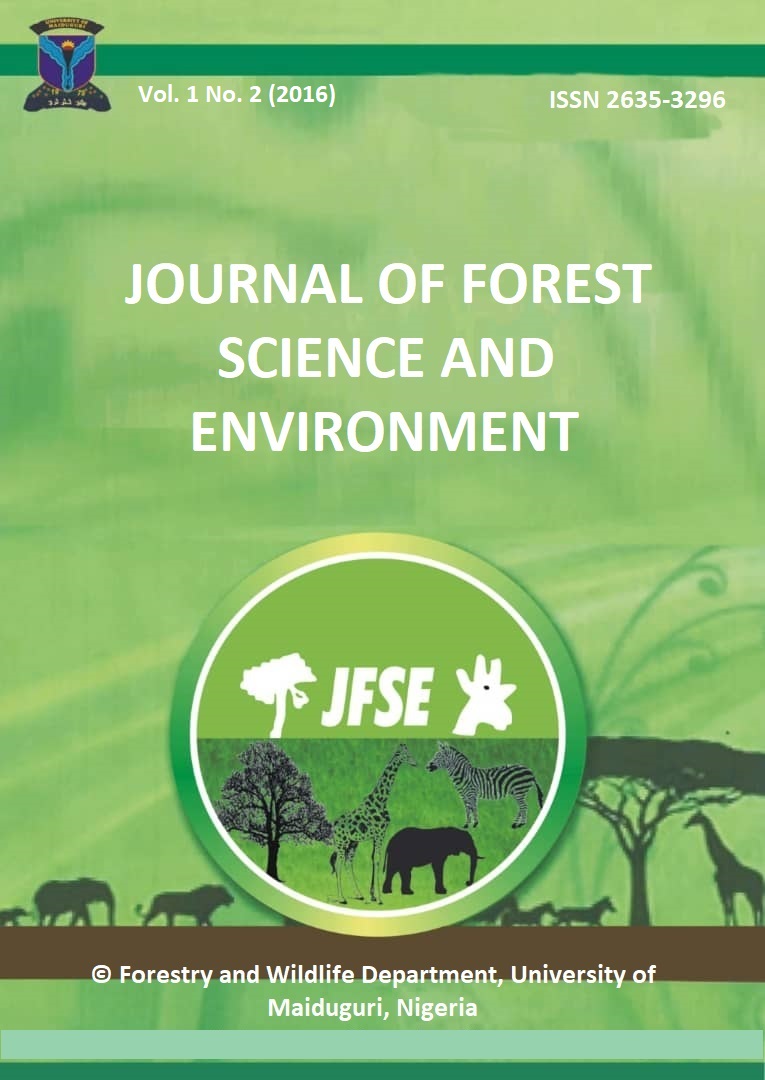Abstract
The interactive effect of (Parkia biglobossa) was investigated on the growth and yield of maize
(Zea mays) over a period of twelve (12) weeks at Ladoke Akintola Research farm Ogbomoso. The
experiment was laid out in Radomized Complete Block Design (RCBD) with 3 treatments and 3 replicates. Data collected were plant height, number of leaves, stem girth. Leaf area, canopy diameter, number of branches and were subjected to statistical analysis using analysis of variance (ANOVA) while the means were separated using Ducan’s Multiple Range Test DMRT at 5% probability level. There were significant differences in the number of leaves and number of branches of P. biglobossa (p≤ 0.05) of both sole tree and the intercropped. Intercropping affected stem girth and canopy diameter of the tested tree specie. The values obtained for stem girth with sole P. biglobossa (6.5 cm) were significantly higher than the intercropped (3.4cm). Higher numbers of leaves were obtained in maize +P. biglobossa intercrop (275.8cm2) compared to sole P. biglobossa (262.4cm2). Sole maize had higher grain yield (0.98 t/ha) than the intercropped maize + P. biglobossa (0.95t/ha) however maize + P. biglobossa had the highest percentage shelling (50.4) than sole maize (41.6). It was therefore concluded that there were positive interaction between P. biglobossa and maize plant. Hence, it could be recommended that there is need to encourage combination of maize and P. biglobossa at the early growth stage for efficient utilization of available land resources and for conservation of the P. biglobossa.
References
Alabi DA, Akinsulire, OR and Sanyaolu MA (2005). Qualitative determination of chemical and nutritional composition of Parkia biglobosa. African Journal Biotechnology, 4: 812-815
Benz BF (1994). Maize origin, domestication and development in carraso D. editor. The oxford encyclopedia of Mesoamerican culties: the cultivation of Mexico and Central America Oxford University Press New York. Pp. 147-150.
Edith Van Walsum (2011). Small Scale agriculture for sustainable society. Farming matter magazine published by ILEIA.
Guinad Y and Dachassa L (2000). Indigeneous food plants in southern Ethiopia reflections on the roles of “farming foods” at the time of draught. United Nations Emergencies Unit from Ethiopia (UNEUE), Addis Ababa.
Hall AE, Thiaw AM and Ehlers JD (1997). Water – use efficiency and drought adaptation of cowpea. Pp. 87 – 98. In: Advances in cowpea research, B.B. Singh et al. (Eds). IITA/JIRCAS, IITA, Ibadan, Nigeria.
Kebu B and Fassil K (2006). Ethnobotanical Study of wild edible plants in derashe and Kucha district, South Ethiopia. J. Ethinobiol. Ethinomed 2:35
Mertz O, Lykke AM and Reenberg A (2001). Importance and Seasonality of Vegetable Consumption and Marketing in Burkina faso, Economic Botany 55(2): 276 – 289.
Odunfa SA (1981). Identification of the micro organisms associated with Iru Fermentation Journal Plant Foods 3:245-250
Olaniyi JO (2006). Influence of Nitrogen and Phosphorous fertilizer on seed Yield and quality of Egusi Melon (Citrullus Lanatus (thunb) mansf in Ogbomoso, South Western Nigeria Ph.D Thesis, University of Ibadan, Nigeria. 199Pg.
Sangakkara UR, Bandaranayake PSR, Gajanayake JN and Stamp P (2004). Plant population and yield of rain fed maize grown in wet and dry seasons of the tropics. Maydica 49: 83-88.
Saxena MC, Singh KB (1985). The Chikpea Chapter 7: Genetics of chick pea, F.J. muchlbauer and K.B Siyh C.A.B. Inter Cent. Sales, Walling ford, Oxon Oxio 8DE UK.
Schroth G (1999). A review of below ground interactions in Agroforestry, focusing on Mechanism and management option. Agroforestry system. 43: 5 34.
Zamir MSI, Ahmad AH, Javeed HMR and Litif T (2011). Growth and yield behavior of two maize hybid (Zeamays L.) towards different plant spacing Cerceceair Agronomice in Moldova. 14(2): 33-40


